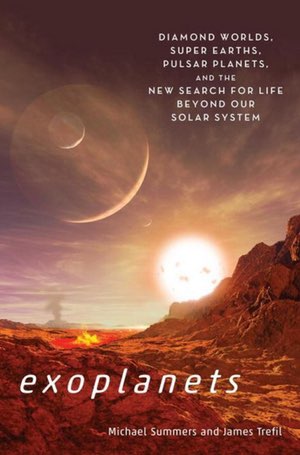Review: Exoplanetsby Jeff Foust
|
| Their breezy survey of the current state of knowledge of exoplanets highlights both the wide range of planets found to date and the potential for such worlds to host life. |
These worlds are interesting because they show the promise, at least, of being Earth-like and thus habitable. However, a planet doesn’t have to be an Earth 2.0 to be habitable: it’s possible many other planets could also support life. That is being tested today in our own solar system, as scientists seek to explore the subsurface oceans of icy moons like Europa and Enceladus thought to have at least the potential to harbor primitive life.
That’s one of the messages of the book Exoplanets by Michael Summers and James Trefil, two professors at George Mason University. Their breezy survey of the current state of knowledge of exoplanets highlights both the wide range of planets found to date and the potential for such worlds to host life.
The book covers some history of the search for planets around other stars, but is not a comprehensive account of those efforts, touching upon the Kepler mission and ground-based surveys. Their focus, though, is profiling some of the wide range of potential worlds beyond our solar system, based on both the discoveries made and projections about what those worlds are like. These include planets with varying amounts of water, in various forms, from worlds of ice to those with deep oceans and no signs of land. Even more exotic planets include carbon-rich planets with liquid diamond cores to “rogue” planets traveling in interstellar space after being flung from the stars around which they formed.
| If primitive life appears to be more common in the universe, then perhaps, they argue, that Great Filter lies ahead of us. |
Much of this is, to be certain, speculation. There’s little actual information about exoplanets profiled by name in the book—like Kepler-186f, described as a “super Earth archipelago world” in one chapter—other than their orbit, size, and mass. It will be up to future telescopes, on the ground and in space, to obtain spectra and, some day, fuzzy images, of these worlds to better understand what they’re like. The authors emphasize the speculative nature of these assessments, but that could be lost on the causal reader skimming through the book.
Any discussion of potentially-habitable exoplanets, of course, turns to the question of life. The authors spend some of the final chapters looking at the search for life, from efforts elsewhere in the solar system to the search for extraterrestrial intelligence (SETI). That discussion leads to the question of why SETI searches have failed to detect any evidence of other civilizations. Beyond the technical issues of such searches, they suggest there may be a “Great Filter” that weeds out the development of technologically advanced civilizations. That Great Filter may be early in the development of life, in which case humanity survived it—something that could be proved if efforts to find life elsewhere in our solar system or other solar systems fail. But if primitive life appears to be more common in the universe, then perhaps, they argue, that Great Filter lies ahead of us.
That may be a bit of a morbid note wrap up a book, but the authors do sound a hopeful note in the epilogue about the study of exoplanets in general, also arguing against various kinds of “chauvinism” that would limit our searches to planets like ours with life like ours. And, if the last two decades of exoplanets studies have taught us one thing, it’s that exoplanets have stretched our imaginations about other worlds, and perhaps other life.
